After a building project finishes, you might notice dust and debris everywhere. This mess needs cleaning before the space is ready for use. What Is Post Construction Cleaning tackles this exact problem.
It’s not just any cleaning; it involves removing construction waste, washing floors, and ensuring every corner shines. Our blog post will guide you through the essential steps and best practices to ensure your new or renovated space looks its best.
We’ll cover everything from hiring professional cleaners to using eco-friendly products. Whether dealing with dust in the air ducts or stickers on windows, we have tips to tackle them all.
Keep reading to learn how to make your space sparkle again!
Key Takeaways
- The process of post-construction cleaning involves three separate stages: Rough Clean, Light Clean, and Final Clean. Each stage addresses different types of mess left from construction, securing the space for safe and clean use.
- Specialists in cleaning take a central part in post-construction cleaning by applying their trained skills and specific equipment to efficiently get rid of dust, dirt, and debris. Their expertise ensures the work aligns with safety regulations and achieves high standards of cleanliness.
- The application of eco-friendly cleaning elements during post-construction cleanup lessens exposure to harmful chemicals, making it safer for individuals and less damaging to the environment. This approach complies with sustainability principles that focus on minimizing waste and managing resources responsibly.
- In 2018, waste from construction actions composed about 38.1% of all the landfill waste in the U.S. As a result, effective waste management actions during cleanup are critical for environmental conservation.
- Engaging professional cleaning services not solely ensures complete cleaning but also supports efficiency by saving time and avoiding errors that could cause redoing the work or postponing moving back into renovated spaces.
Understanding Post-Construction Cleaning
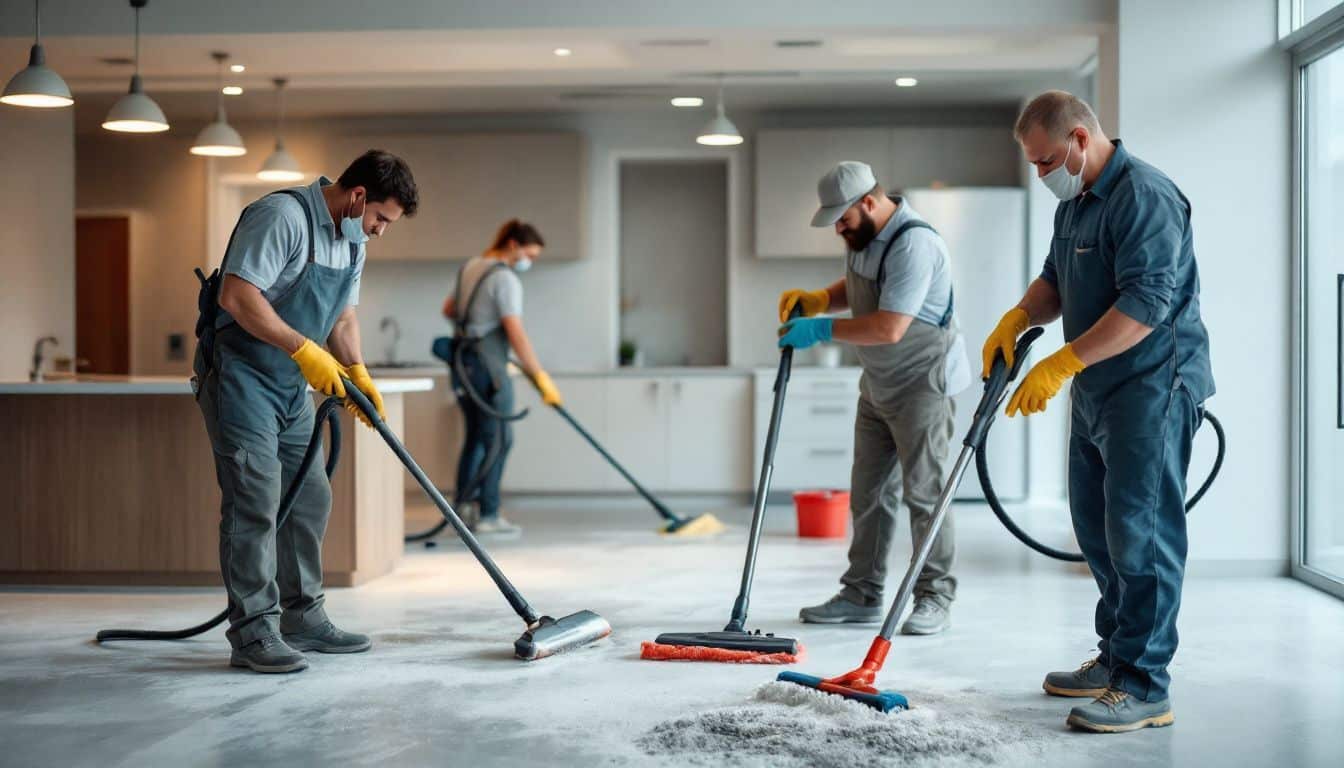
The cleaning process after construction transforms new or renovated areas into secure, tidy spaces ready for individuals to inhabit. This cleaning type isn’t trivial; it reaches into every crevice, making certain that dust, dirt, and potential hazards are thoroughly eliminated.
Staff manage a range of tasks, from vacuuming with HEPA filters to wiping surfaces with microfiber cloths. They ensure no area is missed – including restrooms, kitchens, and countertops.
This sanitary operation consists of multiple stages, each intended to handle varying degrees of mess and clutter. Initially, crews dispose of large waste pieces such as wood offcuts or packaging materials.
Following that, they concentrate on detailed cleaning operations like scrubbing floors and walls or eliminating stickers from windows using specialized instruments like pressure washers and shop vacuums.
This comprehensive process aids in efficient waste management and addresses safety concerns crucial for maintaining optimal indoor air quality and confirming the area is genuinely livable.
The Phases of Post-Construction Cleaning
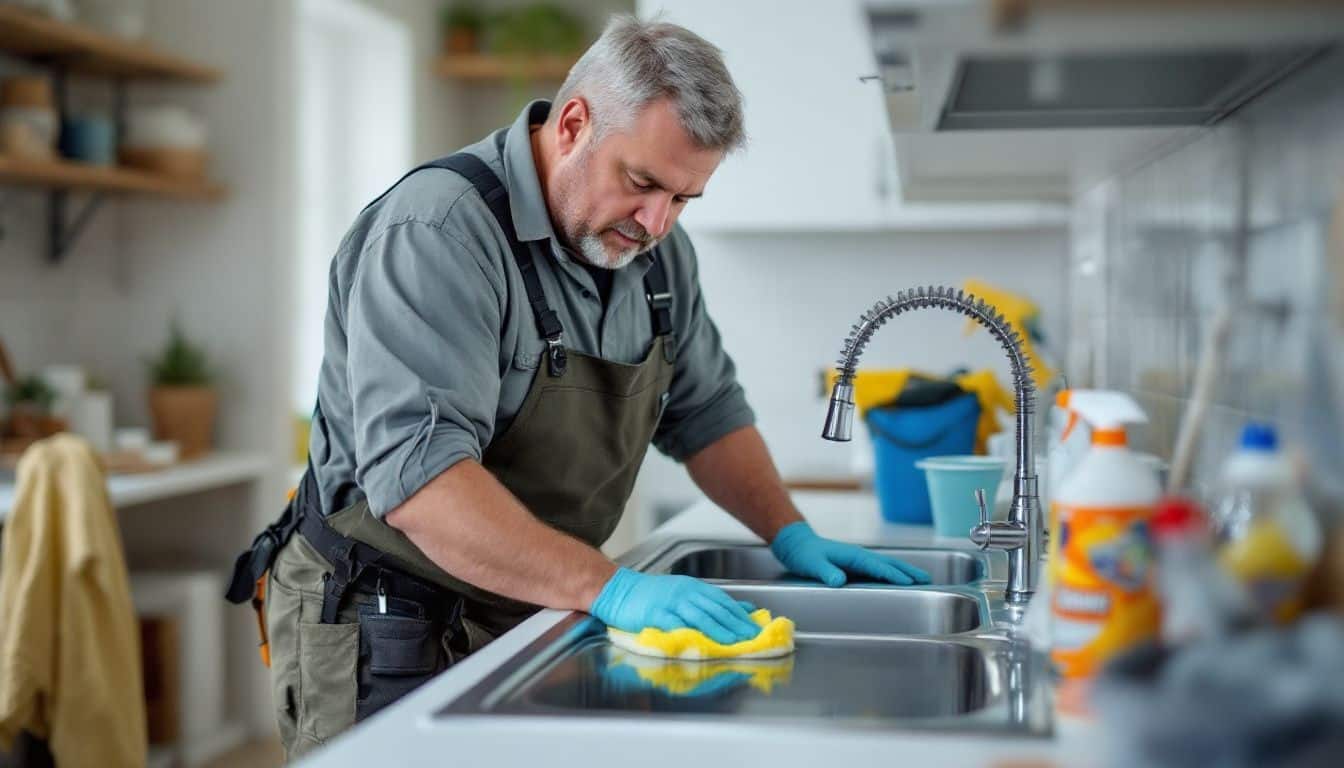
The Phases of Post-Construction Cleaning break down into essential steps to tackle the mess left after building projects. First, workers clear away big chunks like wood pieces and metal scraps during Rough Clean, setting a strong base for what’s next.
Then Light Clean comes in, with crews focusing on getting rid of dust and spots from surfaces such as windows and floors using tools like dusters and mops. Final Clean is all about making everything shine for the owners, involving tasks like scrubbing sinks and shining appliances to ensure a space is ready to use.
Each phase uses specific equipment ranging from heavy-duty vacuums to delicate cloths designed for sensitive areas, ensuring every corner meets high standards of cleanliness.
Rough Clean: Setting the Foundation
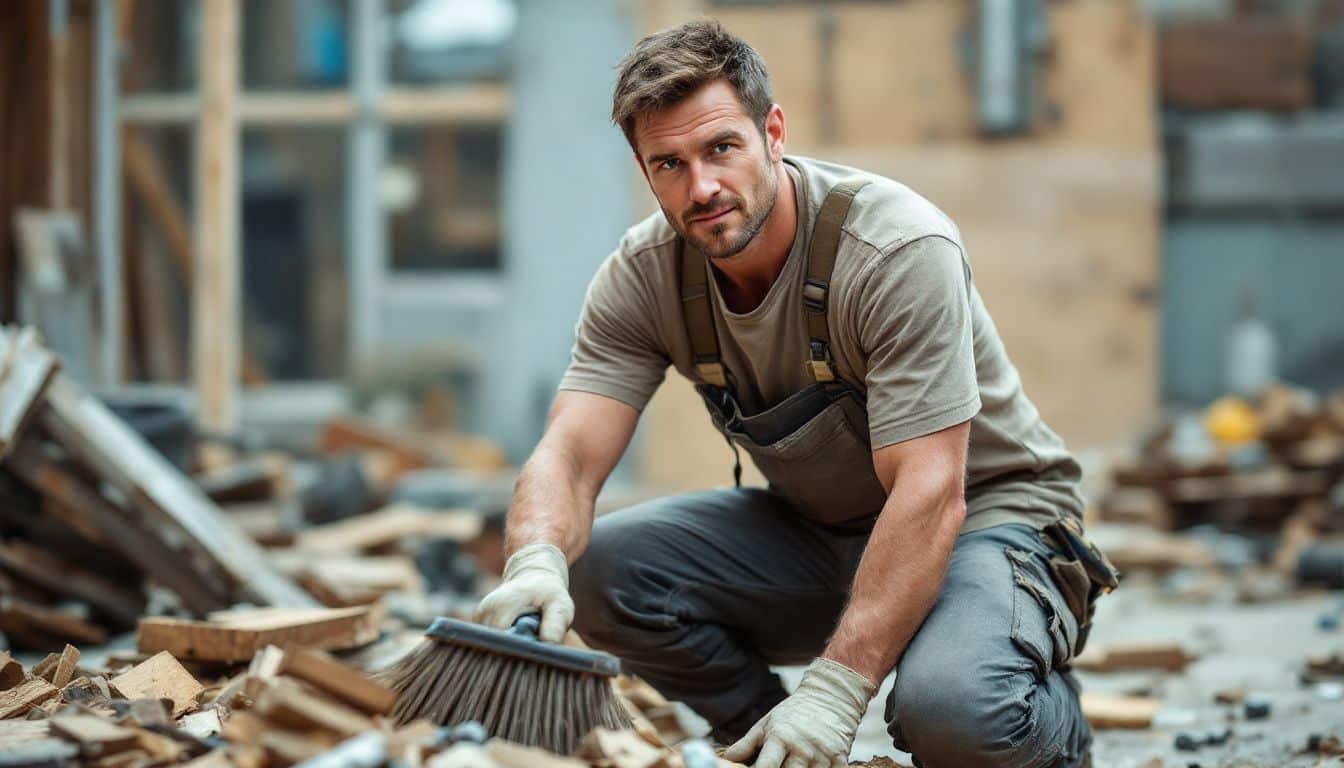
Rough cleaning is the critical first step in making a construction site safe and ready for finer cleaning tasks. It tackles the big mess, clearing out construction debris and setting a clean foundation. Here’s how professionals handle this phase:
- Start with an initial sweep-through to clear away large pieces of construction debris, such as wood fragments, metal scraps, and unused materials. This step is key to preventing safety issues.
- Remove all trash from the site, including smaller debris that might not be immediately visible but could pose risks later on.
- Perform initial dust control measures. Professionals often use air scrubbers to capture fine particles from the air, improving air quality and reducing health hazards.
- Apply wet cleaning techniques for sticky or tough residue. This includes mopping floors and wiping down surfaces to remove any substances like glue or paint.
- Focus on sticker removal from windows, appliances, and cabinets. Peeling off stickers can leave a residue if not done carefully.
- Check ventilation systems for any construction dust or debris that could affect air quality once the building is in use.
- Employ heavy-duty vacuum cleaners designed for construction sites to pick up finer particles from floors and other surfaces.
- Ensure all hazardous materials are identified and properly disposed of according to environmental protection laws to prevent harm to workers and future occupants.
- Inspect every nook for hidden dust or debris that could undermine later phases of cleaning.
- Last, assess the area for any potential safety issues that need addressing before moving forward with light clean tasks.
Light Clean: Precision and Detailed Cleaning
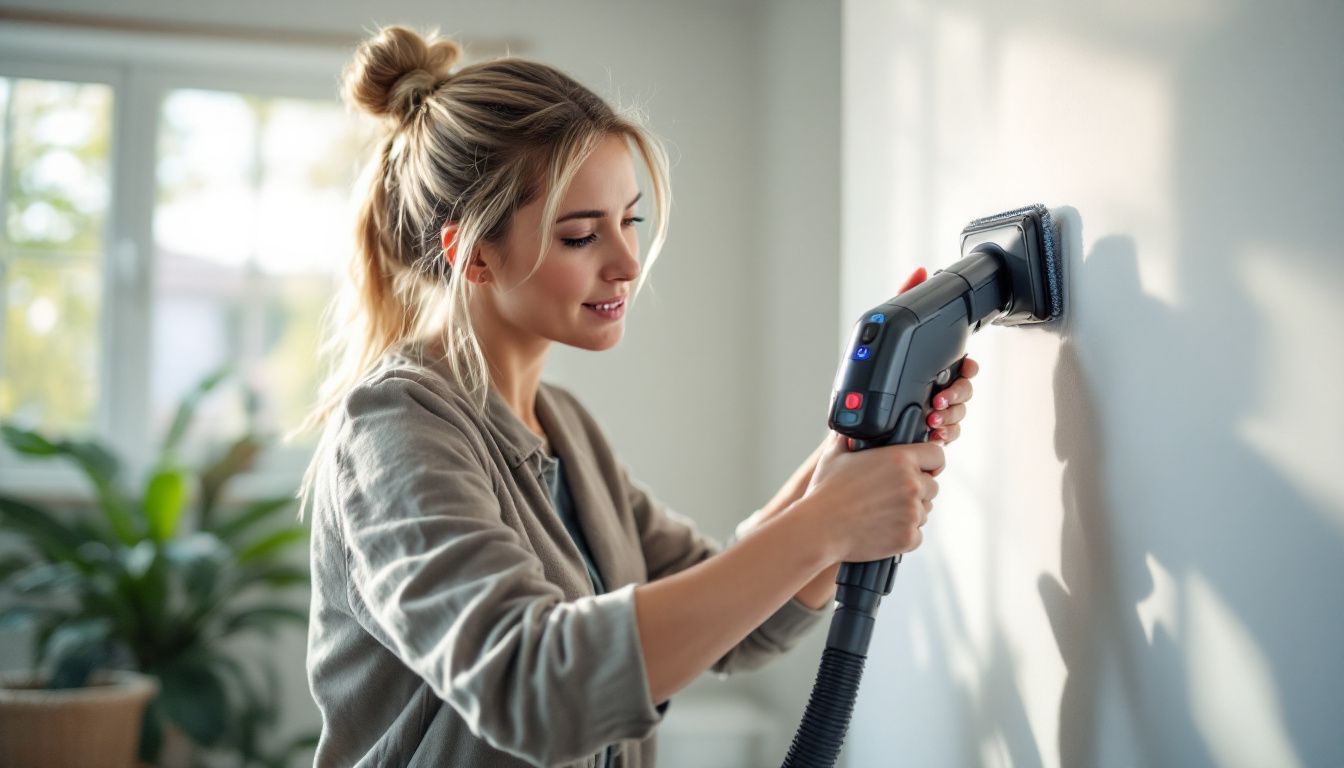
After the foundational debris removal of the rough clean, the next step brings a detailed focus. Light cleaning requires precision and attention to small details to ensure a space shines.
- House owners start by dusting all surfaces, including hard-to-reach areas. This task means tackling every nook and cranny to prevent any dust from lingering.
- They use vacuum attachments specially designed for delicate surfaces. These tools help remove dirt without causing damage, especially on soft surfaces like curtains or upholstered furniture.
- Next comes spot cleaning marks from walls and floors. Parents pay extra attention here, as kids’ areas often need more care due to scribbles or spills.
- Polishing fixtures is crucial for adding shine to a home. This step includes faucets, handles, and railings, making them look brand new.
- Wiping down appliances ensures they are ready for use. Homeowners make sure fridges, ovens, and heaters are clean inside and out.
- Vacuum cleaning extends beyond carpets to all flooring types. A thorough pass removes any remaining dirt hiding in plain sight.
- Cleaning equipment also goes through a clean-up process after use. This ensures tools are in perfect condition for future tasks.
- Safe disposal of any hazardous wastes follows environmental protection guidelines closely. House owners ensure they handle materials responsibly to minimize environmental impact.
- For carpeted areas, using a carpet cleaner that pulls out deep-set dirt refreshes the whole room’s feel.
- Employing microfiber cloths throughout the cleaning gives a streak-free finish on surfaces while trapping dust effectively.
Each step reinforces the importance of not just making spaces look clean but ensuring they meet standards of health and safety for families moving back in post-construction.
Final Clean: Presentation and Handover

he final clean phase is crucial for making a newly constructed space shine and ready for its new occupants. Teams engage in detailed cleaning tasks to ensure the property is visually appealing and ready for presentation.
- Professional cleaners start by inspecting the site to list down all tasks needed for the final clean.
- They remove all remaining construction debris, ensuring nothing hinders the beauty of the space.
- Cleaners wash all surfaces, including windows, doors, and walls, to remove dust and smudges.
- They focus on floors, vacuuming carpets, and mopping hard surfaces to make them spotless.
- Attention turns to bathrooms and kitchens where they sanitize every surface for a germ-free environment.
- The team checks air vents and replaces filters if necessary to guarantee clean air circulation.
- Light fixtures get a thorough cleaning to brighten up every room without dust dulling their shine.
- Workers apply finishing touches by polishing mirrors and glass surfaces to free them of streaks.
- The team performs a touch-up phase days later to address any overlooked spots or imperfections that arise.
- Finally, cleaners do a walkthrough with the owners to ensure satisfaction before handing over the property.
This systematic approach ensures that every corner of the property reflects care and professionalism, making it ready for its new inhabitants while adhering to environmentally friendly practices advocated by organizations like the Environmental Protection Agency (EPA).
Best Practices for Post-Construction Cleaning
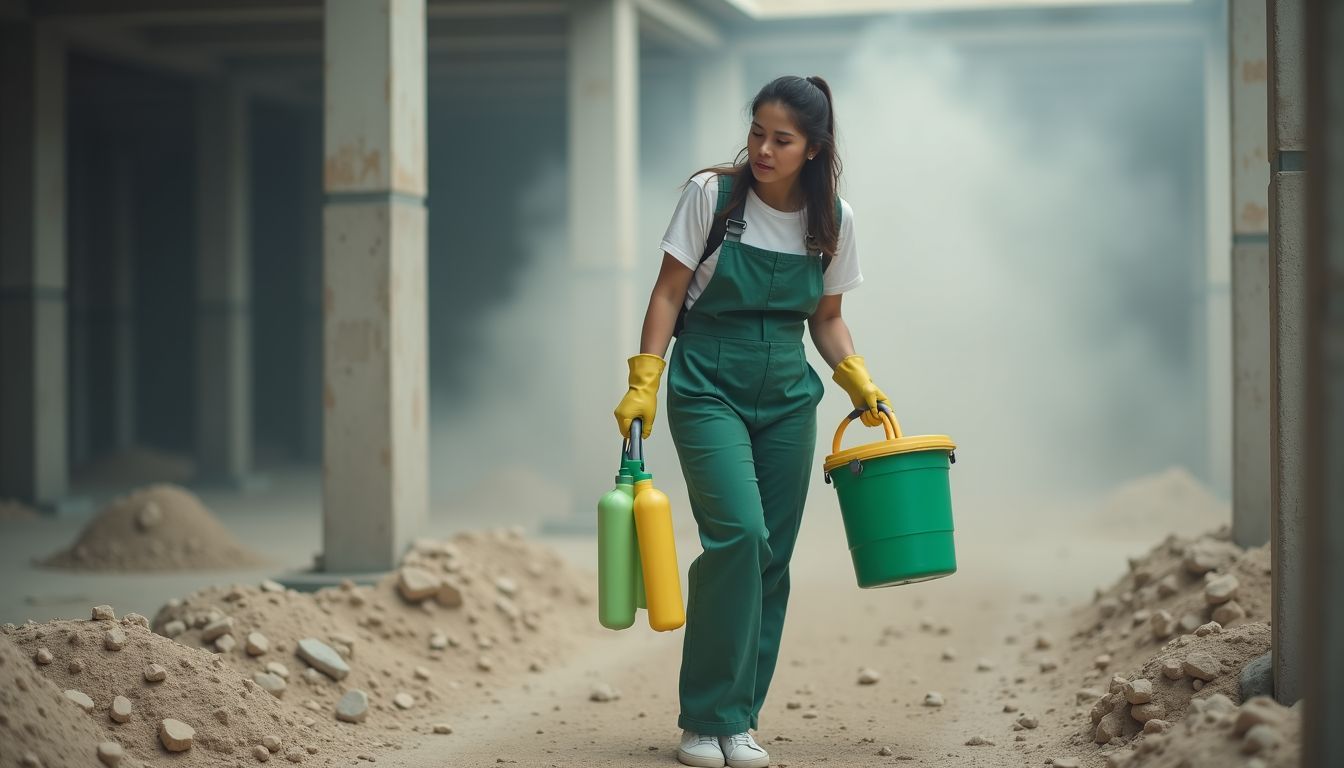
For the best results in post-construction cleaning, consider hiring skilled cleaners who know how to tackle the dust and debris that building work leaves behind. They use green cleaning agents that are better for the planet.
Following guidelines for eco-friendly waste handling is also key in maintaining a sustainable approach. Keep these tips in mind to make your space shine and ensure a healthier environment for everyone involved.
Dive deeper into understanding these practices and see how they can transform your post-renovation cleanup process.
Hiring Professional Cleaners

Hiring professional cleaners for post-construction cleaning brings safety and thoroughness to the job. These experts come equipped with advanced tools and know-how, crucial for tackling construction-site dust and debris.
They assess each project’s scale, ensuring they use the right equipment and strategies to meet homeowners’ needs efficiently. Their experience allows them to spot potential hazards, making sure every corner of the home is safe for children and pets.
Costs can be higher due to the detailed work involved in final cleaning phases, but investing in professionals pays off by saving time and avoiding costly mistakes. Parents looking to move back into their renovated homes value this efficiency.
Cleaners follow sustainability standards closely, choosing eco-friendly products that protect indoor air quality while contributing positively to environmental goals. They manage waste smartly, promoting sustainable waste management practices that align with modern expectations for responsible disposal and recycling.
Using Eco-Friendly Cleaning Products
Using environmentally-friendly cleaning supplies can significantly improve post-construction clean-up. By utilizing these eco-friendly products, harmful chemical exposure is minimized, securing a safer environment for both the labor force and the soon-to-be residents.
Plus, these products also save our surroundings from the negative effects of toxic substances. Such an approach fits perfectly with the rising emphasis on Environmental, Social, and Governance (ESG) standards promoting responsible action.
In the United States, local laws frequently endorse these safer substitutes as part of the waste management plans. Through the adoption of such eco-friendly measures, property owners play a part in a more ecologically responsible way of dealing with after-construction clean-up.
This decision contributes positively to individual health, while also supporting worldwide sustainability initiatives.
Adhering to Sustainability Standards
Adhering to sustainability standards during post-construction cleaning involves more than just using eco-friendly products. Sustainable construction aims to reduce harmful impacts on the environment.
The construction sector was responsible for nearly 38.1% of all landfill waste in the U.S. as of 2018, underlining the importance of minimizing waste through sustainable practices.
Companies like SERVPRO.com lead by example, integrating environmental considerations from early design stages throughout a project’s lifecycle.
They focus on efficiency and performance while managing resources responsibly. Parents and house owners can play a significant role by choosing services that prioritize these values, thus contributing to a healthier planet for their families and future generations.
Next up is understanding why professional post-construction cleaning is so crucial.
Why Professional Post-Construction Cleaning is Essential
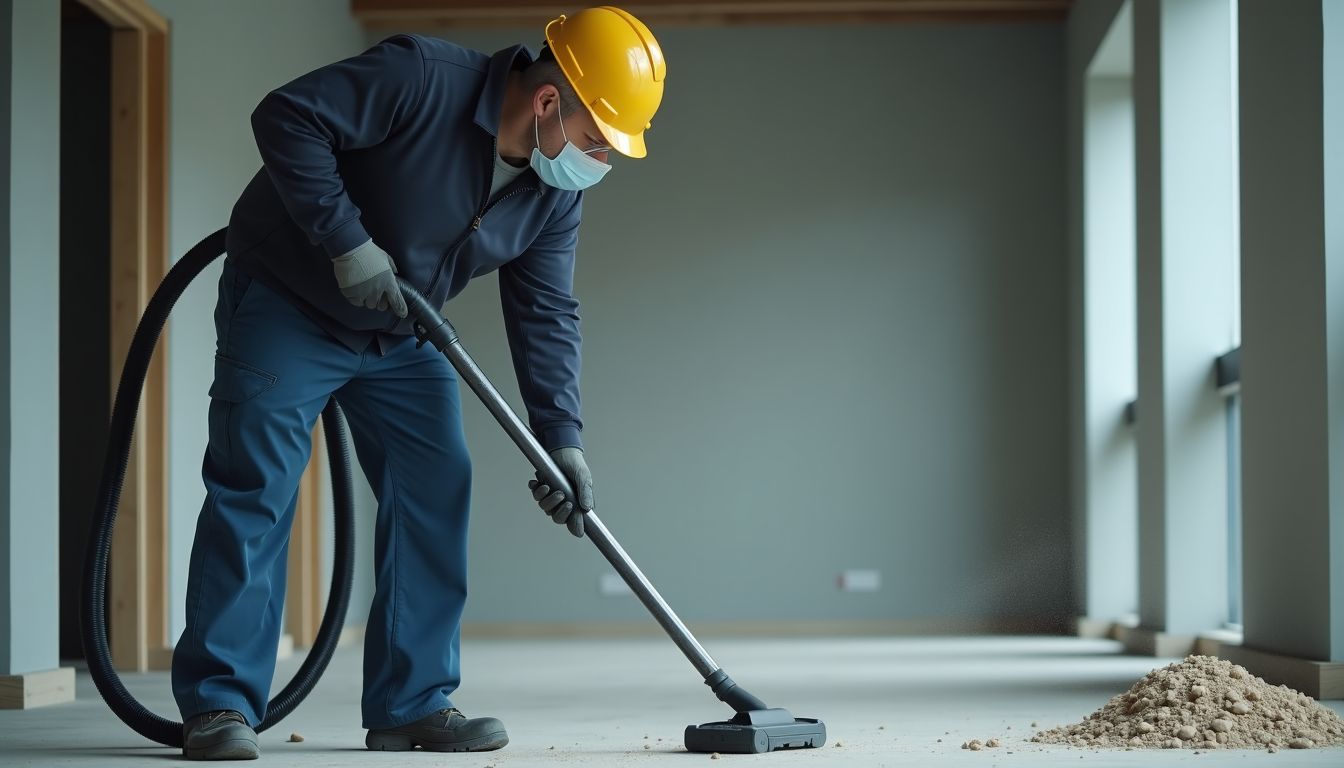
Professional post-construction cleaning services are essential following construction or renovation projects. They ensure the newly modified area is safe and pristine for its new occupants. Specialists offer their expertise, superior cleaning equipment, and environmentally friendly cleaning agents to deal with the aftermath of construction.
This elevated standard of cleaning extends beyond merely removing large waste; it delves into eradicating dust from every corner, ensuring neat floors, and leaving windows glistening.
Such a service becomes necessary as it tackles tasks that require specific equipment and understanding. For example, the accurate disposal of waste as per United States regulations needs comprehension of environmental policies.
Professional cleaners don protective garments to guard themselves from potentially harmful substances while using advanced vacuum cleaners capable of capturing fine particles without dispersing them.
Furthermore, these professionals understand how to manage remaining debris from construction sites in an eco-friendly manner. They adhere to guidelines meant for minimizing waste footprint which aligns with the environmental, social, and governance standards directing contemporary businesses.
Their approach cleans and safeguards our environment.
Ensuring Safety and Efficiency
Hiring professional cleaners prioritizes safety and efficiency in post-construction cleaning. With their protective gear and industrial-grade tools, these experts ensure that every corner is rid of hazardous materials.
Their thorough approach makes the living space safe and expedites the cleaning process. House owners can rest assured as the professionals adhere to stringent safety protocols.
In the spirit of environmental care, the use of eco-friendly cleaning products maintains a non-toxic environment for families. Such products prevent the exposure of your home to harmful chemicals, fostering a secure ecosystem indoors and outdoors.
The proficiency of this service is evident through the open dialogue between the house owners and the cleaning service, guaranteeing that every spot meets the set expectations, eliminating the need for rework.
As a result, parents save time and avoid unnecessary stress as they can quickly settle into their newly built or renovated homes, reassured about cleanliness and environmental impact.
Managing Waste and Environmental Impact
Waste management in construction and demolition significantly benefits from professional cleaning services. Back in 2018, waste from these activities constituted approximately 38.1% of the total waste dumped in American landfills.
Professional cleaning services adhere to stringent waste handling regulations, thereby contributing to a cleaner environment. Their primary strategy involves recycling materials suitable for reuse rather than discarding them.
The use of environmentally friendly cleaning products is another beneficial practice that lessens pollution. This strategy falls under the umbrella of “Environment, Social, and Governance” or ESG standards.
The selection of safer cleaning chemicals, especially for carpet cleaning and general post-construction cleanups, forms a part of this approach. Hence, professional cleaners not only ensure cleanliness post-construction but also actively contribute to environmental protection by mitigating negative impacts on air, water, and soil quality.
Book cleaning services online with My Cleaning Angel. It’s easy and fast. You have to select the type of cleaning and other information, you see the price right away. Just select the date and book it!
Conclusion
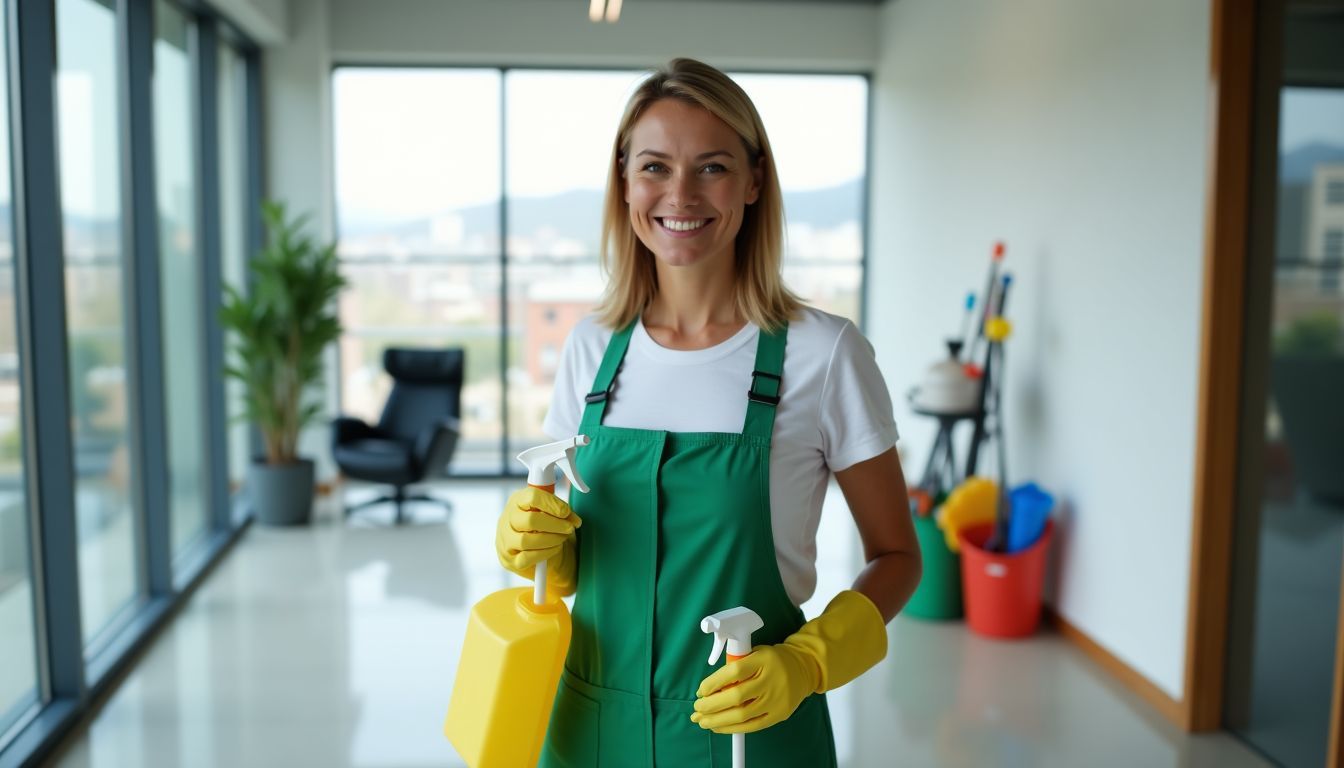
Understanding post-construction cleaning is key for new buildings. This process involves three main phases: Rough Clean, Light Clean, and Final Clean. Hiring experts ensures this job gets done right and safely.
Using green products and following sustainability rules are best practices here. This approach protects our planet while managing waste smartly. Choosing professional cleaners means better safety, less environmental harm, and a spotless space ready for use.
FAQs
1. What is post-construction cleaning?
Post-construction cleaning refers to the process of removing debris, dust, and waste left behind after a construction project. It involves specific phases and best practices to ensure a clean and safe environment.
2. Are there different phases in post-construction cleaning?
Yes, post-construction cleaning typically includes several phases such as initial cleanup, deep cleaning which may involve tasks like clean carpets, and final touch-ups before the space is ready for use.
3. How does waste management fit into post-construction cleaning best practices?
Proper disposal of construction waste is an essential part of post-construction cleaning best practices. In fact, managing construction waste responsibly contributes to reducing overall waste in the United States.
4. Can I find information about post-construction cleaning on the internet?
Absolutely! The internet provides a wealth of resources on this topic including detailed guides on each phase of the process as well as tips for effective cleanup strategies. You can also connect with professionals through online networks or forums who can provide expert advice based on their experiences.
References
- https://progressiveclean.com/what-are-the-phases-of-post-construction-cleaning/
- https://www.cleanestrestaurant.com/post-construction-cleaning-3-phases-and-best-practices/
- https://www.foremanpro.com/the-essential-guide-to-post-construction-cleaning-3-phases-and-best-practices/
- https://southcoastimprovement.com/post-construction-cleaning/ (2024-07-11)
- https://sunlightcleaningny.com/explore-the-3-phases-of-post-construction-cleaning/ (2023-11-27)
- https://www.mdpi.com/2071-1050/13/4/1932
- https://advantagecleaningllc.net/construction/3-phases-post-construction-cleaning/ (2024-03-16)
- https://www.linkedin.com/pulse/essential-benefits-professional-post-construction-lrixe?trk=public_post_main-feed-card_reshare_feed-article-content

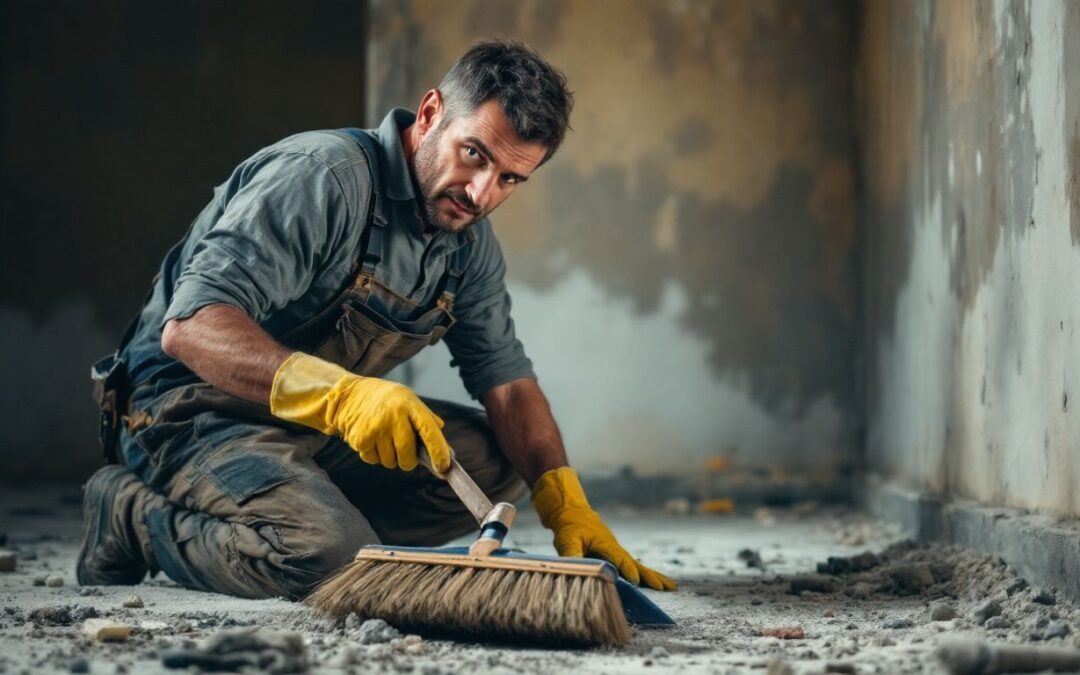





Recent Comments